Rachel Neumeier's Blog, page 313
January 29, 2016
Aladdin: an analysis
Here’s a post by Mari Ness, taking apart Disney’s Aladdin, as is her habit with nostalgic favorites. Not that she hates the film or anything, but her posts do always make me look at a film (or book) in new ways, as she discusses behind the scenes bits and reinterprets plot points.
My favorite tidbit:
Animators … more tentatively decided to try to animate a tiger again. Unfortunately, although computer assisted animation had managed wonders for backgrounds, camera movements, and creating the illusion of a camera speeding through paintings, it had not yet reached the point where it could make animating stripes easy or cheap. As a result, the tiger was eliminated from several scenes, and made to sit very quietly, only moving his head, in others. Animators over on The Lion King hastily reduced the number of zebras.
I always did regret how little space the tiger got! This explains the lack of general tiger coolness in the movie! Also, can’t you just *see* animators zipping over to The Lion King to erase zebras?
Of course I loved Robin Williams as the genie, but I had no idea that, as Ness points out:
Disney also ran into trouble with Robin Williams, who had agreed to do the film at far below his usual rates—as long as Disney did not use his name while marketing and promoting the film. Disney did use his name, leading to a feud that ended only when Joe Roth, who had replaced Jeffrey Katzenberg as the Chairman of Walt Disney Studios, publicly apologized.
That’s interesting, and honestly, I can see both sides. Revealing Robin Williams beforehand must have been just an overwhelming temptation, but certainly if I’d been Williams, I’d have been seriously ticked off.
Anyway, this post does a great job taking the movie apart and putting it back together so that it looks a little different to me. I think Ness writes my favorite posts at tor.com.
Next up, I see Mari Ness says she’s going to take a look at The Lion King. I’ll have to keep an eye out. I really disliked the movie and I’d like to know how many of my thoughts about it get echoed in her post. I will say: I don’t expect Ness to mind the terrible portrayal of lion behavior. I mean, making the bad guy an uncle. An uncle! As if. With lions, no social bond is more important than the one between brothers.
Well, that sort of critique is for people into animal behavior, of course. When I saw it, with a friend, in grad school, we walked out of the theater and immediately redesigned the plot so it would work dramatically while still allowing the lions to behave more like lions all through.
Getting the lions wrong is not why I didn’t like the film, though. So I really will be interested in what Ness has to say about it.

January 28, 2016
The “J” Puppy: from birth to ultimate cuteness
So, I’ve been posting the odd photo on Twitter recently because by now it’s pretty clear that my new baby is doing well.
Is he weaned? Well, no, though he’s been trying out this concept of mushy kibble for several weeks now. He doesn’t find it very exciting. I added a tiny bit of turkey baby food this morning and that certainly got his attention. But Cavalier mothers remain quite tolerant of their little hellions even after the puppies have a full set of teeth, so generally speaking a Cavalier puppy sees no need to rush into weaning.
Still, Puppy “J” is hitting every normal developmental benchmark right on time, or even a bit early, and by now even I am pretty relaxed about him. So here he is at last, with a selection of pictures that lets you all watch him grow up — I’m sure you all like puppy pictures, right? Right! So here we go:
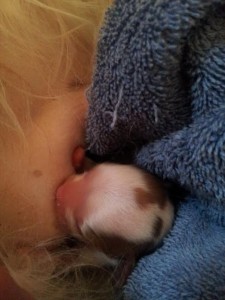
At birth, Puppy J weighed 6.4 oz, a decent size, especially considering the c-section was scheduled 3 days before the due date. That’s the equivalent of 2 weeks early for a human baby. The mother puts a lot of weight on her baby during that last little bit of the pregnancy, and of course the lungs need to get finished off. I’ve saved a puppy that was 5-6 days early, but it’s really touch and go at that point. Come to think of it, that was a grandmother of this puppy. Anyway, three days is the earliest plausible time to go get puppies if you’re concerned about the pregnancy. Given Kenya’s dire trouble with premature labor, I definitely wanted to get her puppies as early as possible, and as you may know, one of the two puppies that was alive at birth did die near the end of the first 24 hours, almost certainly because the premature labor had compromised the placental attachment.
Anyway, focusing on the one puppy, I will say: J was a well-developed puppy with a nearly full coat even on his legs and face. He was plump and strong and behaved in every way like a normal puppy. I have had full-term puppies that were just about exactly his size, although I’ve also had full-term puppies twice as big, so there’s a wide range (and that 12.5 oz puppy was very difficult for her mother to deliver, too). I think a normal weight for a Cavalier puppy is eight ounces plus or minus two ounces.
Puppy J lost a little bit of weight — he went down to a hair under six ounces — but was back up to his birth weight after 48 hours and then started gaining slowly. Of course Kenya did not have a proper milk supply at first, partly because the c-section was three days early and partly because she had a hard time with the surgery, which was a full spay as well as the section. Since J was nursing strongly but not getting enough milk, I tube-fed him half the amount an orphan his size would have gotten. That was 2-3 cc every two hours around the clock.
Tube-feeding is exactly what it sounds like: you run a feeding tube down the puppy’s throat and inject formula directly into his stomach. This is very easy, actually. It’s much quicker than feeding with a bottle, you don’t have to try to get the puppy to accept an artificial nipple, there is no chance of the puppy choking if you do it right, it is easy to ensure that you are in fact doing it right (first you measure the tube, but also you can pinch the puppy to make him cry; if he can cry, the feeding tube is definitely not in the trachea), and you can be perfectly certain how much formula the puppy gets. And of course it requires no energy or effort from the puppy, which is very important if the puppy is weak for any reason.
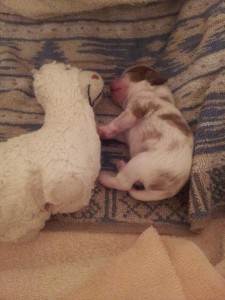
Here is Puppy J at one week, next to his llama so you can judge his size properly. He was gaining weight well by this time, looking on track to double his birth weight by ten days, which is what you expect from a puppy that’s in good shape. Puppies always pile up and drape themselves over their littermates, so this llama was Puppy J’s littermate. He nearly always lay across the llama, not next to it, but I wanted a picture side-by-side to provide a size comparison.
Single puppies are at dire risk of getting chilled, so Puppy J was always nestled with his llama on a special heating pad (it heats up to the temperature of a mother dog, no higher, so there’s no chance of burning a puppy) with a towel dropped over him to conserve heat, or else nestled against his mother’s tummy with a towel dropped over him for the same reason. He was never, ever left unsupervised during this period, not even for a few minutes, to avoid any risk of him getting chilled or of Kenya stepping on him.
By this time, btw, Kenya was feeling much, much better. She had accepted the puppy from the first moment because after all she’s done this before, but she really started acting like a good mother at about this point. I was weighing the puppy three or four times a day, though, and tube-feeding if his weight seemed to stall out.
Moving on:
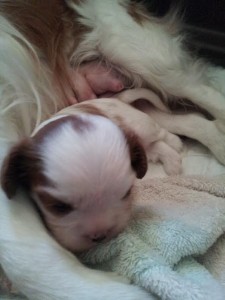
Here Puppy J is two weeks old, counting from his proper due date. A puppy is supposed to open its eyes anywhere from ten days to fourteen days, depending on what source you look at, but in fact I’ve never seen a Cavalier puppy open its eyes before thirteen days. Full-term Cavalier puppies open their eyes from thirteen to fifteen days, with an average of fourteen point something. Premature puppies open their eyes somewhere between sixteen and twenty days depending on just how premature they were.
Puppy J gave me a day of mild concern because he opened one eye on day sixteen and the other on day seventeen — I’ve never seen that before! Apparently it happens now and then, and nothing was wrong with the slow eye. Obviously his eyes opened right on time considering he was three days premature.
Incidentally, before the eyes open, the puppy is said to be in the “vegetative stage.” Its brain waves are basically the same whether it is awake or asleep, so that’s a very suitable term for this period! Once the eyes open, though they still can’t really see much, their brains start developing really fast and very soon they start looking like little puppies.
Puppies are supposed to be up on their feet (but very wobbly) at two weeks. I’ve never had a singleton puppy who managed that; usually the singletons are too fat to get up that early because they get a generous amount of milk all to themselves. Puppy J, however, actually *was* up at two weeks. I was very surprised!
But then his weight stalled out and I realized his mother might not have quite such a generous amount of milk as she had in the past, which explained why Puppy J was a good weight but not fat. I upped her food a trifle, started adding water to her food (kibble soup! Luckily Kenya is a total pig and will eat ANYTHING, no matter what you do to it), and tube-fed the puppy three times over the course of about two days. By this time I was feeding 15 cc at a time, so you can see how much bigger he was by then. Kenya’s milk supply or the puppy’s strength improved, or both, and for the second time I retired the tube, this time for good.
And not before time, either, as by two weeks a puppy is aware enough of the world to be seriously peeved at the tube-feeding process and Puppy J did not like it at all. But very soon he started gaining properly again, about an ounce a day, just what I like to see. And by three weeks, he was actually pretty steady and juuuuust barely starting to show the first signs of play, biting clumsily at Kenya’s ear after nursing rather than falling straight back to sleep.
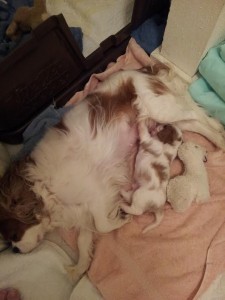
At three weeks, as you can see from the above, the puppy really looks like a puppy!
This is the point at which I start encouraging the puppy to leave the whelping box. I think singleton puppies are usually a little behind with their social development because they don’t have siblings to push them along. Whether the puppies are alone or have siblings, though, I always turn the whelping box over to create a den, like so:
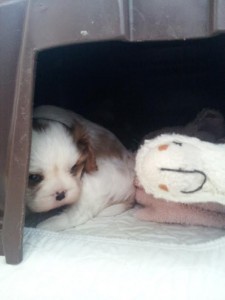
Here Puppy J is about four weeks old. He had learned all about dens and safety and will toddle into the den to sleep. Or for that matter, dash into the den if he feels insecure — for example, if the other dogs suddenly start barking.
However, he is not intrinsically afraid of the other dogs, and this is the age at which I start to let the other dogs meet him. I was so pleased with Chloe, because she very quickly taught herself to lie down to play gently with Puppy J. She is by far his best playmate now, as the other dogs became less interested once they got a look at him.
Kenya, however, was VERY VERY SUSPICIOUS of the other dogs’ intentions, and particularly of Chloe — maybe because Chloe is only seven months old herself, maybe because Chloe is new to my household, maybe because Chloe struck Kenya as too intensely interested. Here is Kenya glaring at Chloe:

I, however, insisted that Kenya tolerate the other dogs, including Chloe, and now Kenya tends to snooze through open play sessions. Kenya is a good mother, but she isn’t at all playful, which is why I was determined that she MUST allow the other dogs to play with her puppy!
For about a week, Puppy J would bounce adorably at other dogs and then fall over sideways (also adorable). In just the past couple of days, he has got so much steadier on his feet! Here is Puppy J playing with Chloe this morning:
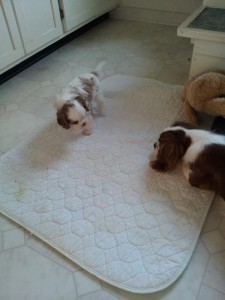
Puppy J is five weeks old today, counting from his proper due date rather than the c-section date. As far as I’m concerned, this is where he hits the Ultimate Cuteness stage, which will last for about another five weeks. After which, yes, he will still be quite cute, eventually transitioning to elegant.
Junior looks like he’s just fine as far as structure and bone and proportion. His baby head looks promising. His markings are fine. He still has four cosmetic issues that could cause trouble. Only one could stop me from keeping him. In order, these are:
I would like him to have double-pigmented eyes, ie, the sclera should be pigmented brown. Any white in the sclera is a strike against a Cavalier in the show ring, though this won’t necessarily stop a dog from finishing a championship. Kenya has a white area of sclera in one eye and she finished. So did Kenya’s daughter Honey. Hopefully Junior got his eye pigment from his father, Ishmael, but it will be impossible to tell for sure till he’s older.
I would like Junior to not have freckles, at least not on his face. At least not more than one or two small freckles. Preferably not between his eyes. Freckles appear at about three months, so it’ll be quite some time before it’ll be clear whether he’s going to freckle up and if so, how badly. Ish has freckles on his face, but Kenya doesn’t, so I’m really hoping Junior follows his mother on that one.
Ish’s mother had a fairly significant underbite, Ish himself has a nearly correct bite, and I would really like this puppy to have a completely correct bite (like Kenya). Right now his bite is correct, but he barely has teeth! The bite can come in correct and then go wrong. It can go from correct to under and back again, and in Cavaliers it often does. I had one dog whose correct bite went level when she was three years old! No telling how Junior’s bite will settle, but if it improves at all on on his father’s, it will be acceptable.
And … the one problem where there’s no wiggle room at all … if a male dog doesn’t eventually have two testicles descend to the correct place, he’s hopeless as a show and breeding prospect. Ish was late to settle that issue, so I’m kind of expecting a long wait before I’m sure about Junior. I’ve read that about 13% of male puppies have a problem with this, but I have my doubts about that number. Either way, nothing to do but wait!
You see why I am truly sorry not to have more than one puppy, since all these things need to line up properly to give Justinian a chance to be a great show dog. Well, at least he started off by being male and well-marked, or the rest would be irrelevant.
Finally! Answering the important question: DOES PUPPY J HAVE A NAME?
Yes and no! For his formal registered name, I have picked Justinian. Won’t that look nice on trophies? Champion Anara Justinian, I can see it now! With a string of performance titles after his name just to give it that complete look.
For his casual call name, I dunno. Right now I’m just calling him Junior, which of course starts with J, so who knows, that may last for a while. I’m not crazy about the name Justin for a dog, though (obviously, if you’ve read PURE MAGIC) I like it for a person. I could perfectly well call him Jay. Or Tin. Or Tiny. Or I could just pick anything I like and call him, for example, Jos.
The most important thing is that at this point, he is healthy, happy, and on his way to being a well-socialized little puppy.
Here’s my favorite picture of Junior so far, taken at the beginning of this week, during his first exploratory trip to the Big Dog country of the living room:
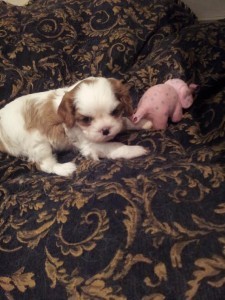

January 27, 2016
25 Truths about Writing
From Chuck Wendig at Terrible Minds, 25 MORE HARD TRUTHS ABOUT WRITING AND PUBLISHING
Right from Truth #1, this is a really good post. Here’s #1:
YOU’RE ALWAYS ABOUT 12 TO 24 MONTHS FROM DYING IN THE ABYSS
I talked about this in one of my more recent posts (advice for the mid-career writer) — but looking ahead a year or two down the line, most writers will see a cliff. This cliff represents the end of your current contracts, maybe the end of a series, and at that point you should expect your career to become a giant blinky spinny question mark.
I have to say, this is certainly true for me and I’m sure it is for most writers. I deal with it by being optimistic! I assume Things Will Work Out! I am *glad* to have all four books under contract written and three mostly revised! I really am! But I do need to write something else now. On spec, probably. This is okay, by this time I think it’s clear that I like writing on spec better than writing to a deadline, but yes, there is that giant blinky question mark up there in the near future, just as Chuck says. Yep, yep, there it is!
I’m an optimistic person in general, more or less, which is good, otherwise my nerves would probably be shot. I think I use up my entire quota of pessimism when I attempt to breed a litter and there’s nothing left but optimism for the other areas of my life. (My new puppy is fine, btw, post coming soon with many cute pictures).
Lessee, what other Truths does Chuck point to? Okay, here:
#2 SOCIAL MEDIA WILL NOT SELL YOUR BOOKS
#3 YOUR BOOK MAY NOT SELL FOR A LOT OF UNCONTROLLABLE REASONS
#4 QUALITY MATTERS LESS THAN YOU’D HOPE
#5 LUCK MATTERS MORE THAN YOU’D LIKE
#6 YOU HAVE MORE POWER THAN YOU DESERVE
#7 AMAZON AND BARNES & NOBLE HAVE WAY MORE POWER THAN YOU
#8 SELLING POORLY CAN MARK YOU
#9 … AND SO CAN SELLING WELL
And here I must say, wow, I would love to have this particular problem! Chuck does say that, too, like this:
Selling well is amazing! Go you! Now you can pay bills and buy cool stuff and fans carry you around on a motherfucking palanquin. It’s all cake from here. And what I mean is, it’s all one flavor of cake. I hope you like that flavor because now if you try to write something of a different flavor, nnnnyeah, it may not work. A big successful book is like a moon orbiting you — that bastard has gravity, and it will affect all your tides. It will be harder to pull away from the thing that made you successful and harder to do something more creatively satisfying. Maybe that’s okay. Maybe it feels like an ART PRISON. But it’s something to note! A good problem to have, admittedly — but it can still be a problem.
To which I’m sure 99.99% of all writers respond, Hah hah hah my heart *bleeds* for you, super-successful writer! Where is my violin?
If I ever have this *cough* problem *cough*, I hereby solemnly vow to handle the typecasting issue with grace and forbearance.
Okay, moving on:
#10 NO ONE WAY IS A LOTTERY TICKET
I think he actually means, no one way is a golden ticket to sure success, but click through and read the entry yourself and see how you interpret the lottery ticket thing.
#11 BIGGER ADVANCE MEANS BIGGER MONEY SPENT ON YOUR BOOK
Analysis: Not absolutely sure this is true, and also not totally positive what a publisher counts as a big advance, but I’m sure there’s some truth to it.
#12 PUBLISHERS DON’T ALWAYS KNOW HOW TO SELL YOUR BOOK
Analysis: Absolutely true, alas. No one knows how to get a book to take off for the stratosphere, or we’d all be a lot less surprised by mega-hits like FIFTY SHADES.
#13 GETTING THAT FIRST BOOK PUBLISHED IS LIKE YAY, AND THEN, OH SHIT
Meaning:
You’d gnaw your own arm off for some data. … BookScan is about as accurate as you throwing shoes at cars.
Analysis: True! But getting your first book published is still totally a YAY thing! After your book hits the shelves, though I recommend a firm policy of never looking at sales data and only ever reading good reviews. Way easier on the nerves that way!
#14 GETTING THAT SECOND AND FOURTH AND TWELFTH BOOK IS THE SAME WAY
Analysis: Definitely true! I am even now waiting anxiously for reader reviews of THE KEEPER OF THE MIST. Which got a starred review from School Library Journal, btw! So that’s good!
#15 PEOPLE ARE GOING TO HATE YOUR BOOK
Analysis: Alas, true! Also, of course, people are going to love your book. See above for my soothing policy regarding reviews.
….And ten more Truths About Writing, complete with snarky commentary, if you’d care to click through. As is usually the case for Chuck Wendig, the post is fun to read, but a bit long. (I enjoy long posts. But 15 points is enough to copy over here.)

January 26, 2016
Find-and-Replace is your friend
Here’s a post by Nancy Jane Moore at Book View Cafe, on using the find-and-replace function to check on pronoun use — in her case, because she was writing an ambigender novella.
Well, I can tell you, she is dead right about the usefulness of the find-and-replace, or even just the find function alone, only she does not go far enough. Here’s where I have used it lately:
1. To remove a character from the manuscript. When you are taking out a character, the Find command is invaluable to make sure the character is in fact completely and totally removed from the manuscript.
2. To change the word “imaginary” to the word “ethereal” throughout the manuscript. For good and sufficient reasons, I assure you. Incidentally, it is possible to find-and-replace only italicized instances of the one word and replace it with an italicized version of the second word. I didn’t know that until last night, but under the correct rather peculiar circumstances, it is extremely useful that you can do that.
3. To check and see that a particular word is in fact italicized throughout. You can search for italicized and regular versions seperately. Again, I just confirmed that last night.
4. To check that a particular misspelling that plagues you has not occurred. I am thinking here of character names. Is the names Diollonuor or Diollunuor? If your fingers couldn’t tell the difference and you accidentally added both spellings to your working dictionary, find-and-replace can fix the problem.
5. To change one word into another word because you have changed your mind. I once changed “arrow” to “bolt” everywhere because I changed the bows to crossbows. Incidentally, you must then be on the lookout for words like “spbolt,” where you used to have “sparrow.”
6. To get rid of every “all right” because the publisher was bound and determined to spell the word “alright,” a usage I detest with the passion of a white-hot burning sun.
7. To go through your entire manuscript and look at every. single. dash. Also semicolons, the word “very,” and so on and so forth. This is incredibly tedious and annoying, but taking the time to do this will almost certainly result in a smoother reading experience in the end.
Good lord, this is turning into a top ten list. Three more reasons to use Find or Find-and-Replace?
Okay,
8. I once named a main character Brendan, then at the last minute read a newly published book I thought comparable to mine that had the same name for its protagonist. I thought the two books might share enough of an audience to make this awkward, so I changed my character’s name (to Bertaud, whom you may recall).
9. In fact, speaking of character names, my Saga editor, Navah, suggested that MOUNTAIN had too many characters whose names started with the letter G. Find-and-Replace is perfect for changing some of the names.
10. I’m out. Anybody else use a Find or Find-and-Replace for something I missed?

You all know about the aliens’ Dyson sphere, right?
At a blog called Bad Astronomy, a post by Phil Plait: I’m STILL Not Sayin’ Aliens. But This Star Is Really Weird.
The post is about star KIC 8462852, which is this F-type star in Cynus, right, only it’s been fluctuating in luminosity and actually fading over time, and by “fluctuating” and “fading” I mean it loses up to 22% of its brightness at times. Not periodically, just at random times. It’s also lost 20% of its overall brightness over past 100 years or so.
All this is of course impossible.
In the original paper, Boyajian and her team make a good case that the dips are not caused by some odd thing going on in the data themselves or in their analysis of them. Whatever is going on, it’s real. They go through a bunch of possible scenarios that might be causing the dips and wind up eliminating most of them. . . .That left some speculation about, um, aliens. … An advanced civilization would have big energy requirements, and it would make sense to build huge structures around their star to capture as much light as possible for solar power. The dips in light we see are then these “megastructures” passing in front of the star (some people call this a Dyson swarm, a collection of enormous solar panels enclosing the star).
Of course there are problems with this explanations, too. Yet . . . we all know the Truth, don’t we?
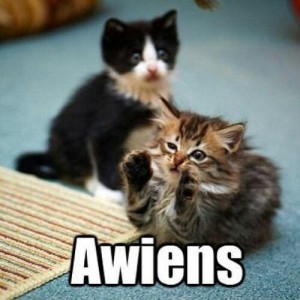

January 25, 2016
Almond Cheesecake Ring
This recipe is based on one from the 2006 Cook’s Country book, which contains an inviting recipe for an Almond Ring Coffee Cake by Katie Henderson. Naturally I didn’t make the recipe exactly as offered in the book. I made this instead, and it was really good, so here you go in case you want a fairly impressive bread that is really quite easy to make.
Filling:
The original recipe suggested 7 oz almond paste combined with ½ C powdered sugar and 4 oz cream cheese. I think almond paste is definitely sweet enough and can’t see adding sugar to it, but the cream cheese sounded like a fine idea. I used this filling:
1 (8-ounce) package cream cheese, softened
5 ounces almond paste (approximately; I used whatever I had in an open can.)
1 egg
Beat the filling ingredients together until pretty smooth. Set aside.
Bread:
The original recipe used 3 egg yolks, reserving the whites for a pre-baking wash in order to get lots of sliced almonds to adhere to the top of the bread. I skipped the almonds, thus didn’t need the egg white wash, so I just put one whole egg in the bread. It’s a really rich bread, made like so:
1 1/3 C warm milk
1/3 C honey
8 Tbsp butter, melted
1 egg
2 tsp vanilla extract
4½ C flour
2 tsp salt
2¼ tsp instant rise yeast
Warm the milk, warm the honey, melt the butter, and beat all of those together with the egg and vanilla. Combine the flour, salt, and yeast in the bowl of a stand mixer. Fit the mixer with the dough hook, turn the mixer to low, and add the liquid ingredients in a steady stream. Then turn the mixer gradually up to medium and knead four to six minutes, until the dough is smooth and a little sticky. Or make the dough with a bread machine or by hand, whatever you prefer.
Oil your hands and a fairly sizable bowl, shape the dough into a ball, place in the bowl, cover, and place in a warm place to rise. Henderson suggests heating the oven to 200 degrees, turning it off, and letting the dough rise in the oven. That’s a REALLY warm rising temp, but I did it that way and it worked just fine. The dough about doubled in 25 minutes, a fast rise, but at that temperature, no wonder.
Divide the dough in half and put half back in the bowl. Roll out the first portion to an 18 x 9 inch rectangle. Like most yeast dough, this is very easy to handle and no trouble at all. Spread half the filling on this rectangle and roll up the long way, forming an eighteen inch coil. Pinch to seal. Place on a parchment-lined baking sheet, coiling into a circle. Now take a paring knife, oil the knife, and make cuts to the outside of the ring, not all the way through, about an inch apart. Nudge the ring a little wider to separate the cuts. Look at the picture below if it’s not clear how this should look. Cover the first ring and put into the warm oven. Repeat the process with the other half of the dough, obviously. Let the rings rise about 30 minutes.
Remove the bread from the oven, preheat the oven to 375 degrees, and bake for 25 minutes. Rotate the baking sheets and bake another five minutes. Remove and set the baking sheets on racks for five minutes. Then slide the rings from the baking sheets to the racks to cool. I had no trouble moving them.
Now make the glaze while they cool. Henderson used a lot of powdered sugar (1½ C), a bit of milk, and 2 oz cream cheese. That’s a good start, but I was playing up the cream cheese, so I made the glaze more or less like this:
Glaze:
1 C to 1½ C powdered sugar (I didn’t measure it, just dumped some in a bowl)
1 Tbsp to 2 Tbsp milk ( I didn’t measure this, either, sorry, but it was enough to make a fairly thin glaze if I hadn’t added the cream cheese)
4 Tbsp cream cheese, softened.
Whisk glaze ingredients until smooth. Now, the way I did it, the glaze was really too thick to drizzle out of a spoon. I doubled over a long sheet of plastic wrap, poked two small holes in the middle of the plastic with a thin fillet knife, spooned the glaze onto the plastic, gathered it up, and piped tons of the glaze over each ring until it was used up, which was quite a generous amount. Mmm.

One ring came to work with me today. I devoured an embarrassingly large portion of the other ring while it was still arm and took the rest to my parents to get it out of my house. Did I say mmm? Mmm.

January 24, 2016
Hugo Winners Face Off: Narrowing it down
Okay, suppose you look at the following pairs of winners:
In this corner, from 1961: A Canticle for Leibowitz. And in this corner over here, from 1966, Dune! Who wins? Personally, I think that one is obvious.
How about this trio: From 1970, The Left Hand of Darkness goes up against The Dispossessed (1975) and The Forever War (1976).
And another trio: Startide Rising (1984) goes up against both Neuromancer (1985) and Cyteen (1989).
Then we have A Fire Upon the Deep (1993) against Mirror Dance (1995).
Getting close to the present day, lots of tight contests gives us a four-way face-off between A Deepness in the Sky (2000), Paladin of Souls(2004), Jonathon Strange and Mr Norrell (2005), and The Yiddish Policeman’s Union (2008).
And finally, it seems only fair to pit Ancillary Justice against last year’s winner, Three Body Problem. This is the first appearance of Three-Body Problem, which had no group to join since 2015 would have started a new group of five years. So bringing it in now, how do you think it matches up?
I can certainly pick my winners easily in most cases:
1. Dune
2. No vote because I only read Left Hand
3. Cyteen
4. Umm, okay, not easy in this case, but A Fire Upon The Deep.
5. Jonathon Strange and Mr Norrell is the one I’d pick, even though I liked Paladin of Souls better.
6. Ancillary Justice walks away with it considering I didn’t actually like Three-Body Problem.
How about you all? Would you pick the same ones or not if you tighten up the contest like this?

January 23, 2016
Ooh, poetry!
At File 770, some delightful parodies of poems that I’m sure you’ll recognize.
This Is Just To Say
I have consumed
the pixels
that were in
the scroll
And also
Once upon a laptop blurry, while I pondered, weak and bleary,
Over many a quaint and curious pixel of forgotten scroll—
While I nodded, nearly Skyping, suddenly there came a typing,
As of some one faintly sniping, sniping at the pixel scroll.
“’Tis some commenter,” I muttered, “sniping at my pixel scroll—
Only this and nothing mo’.”
And this one:
pity this busy monster, fanunfandom,
not. Blogging is a comfortable disease:
your victim (news and comfort safely beyond)
This is something I have no talent for. Shoot, I think I have anti-talent for this. I can’t believe how good at it so many other people are. Click through to read each one in its entirety, plus many others.

January 22, 2016
Hard vs Soft SF
Over at tor.com, a post about Hard vs Soft SF. Fran Wilde asked a bunch of authors to weight in on these terms. Mostly they cooperated pretty well by sticking to the terms given; sometimes they jump the fences.
I agree with Elizabeth Bear, who says:
I feel like the purported hard/soft SF divide is one of those false dichotomies that humans love so much… The thing is, it’s really arbitrary. … I think the habit of shoving all of this stuff into increasingly tiny boxes that really amount to marketing categories is kind of a waste of time.
I think identifying the terms as marketing categories is key. Or rather, I think that “Hard SF” is fairly identifiable and a useful marketing category, in a know-it-when-I-see-it kind of way rather than as a firm definition. But “Soft SF” means way too many different things to different people and is a completely useless term, used mainly because people do like dichotomies and if you have “hard” then naturally you must have “soft.”
For years and years, I’ve been contrasting Hard SF with Sociological SF, neither of which includes science fantasy or space opera. I’ve been so, so pleased to see Sociological SF make a resurgence. For a while there it seemed to be CJ Cherryh and nobody, and now it seems like publishers are making more room for this category of SF, whether thanks to Ann Leckie or what I don’t know, but GOOD.
Sociological SF:
Famous and seminal: The Left Hand of Darkness, so I’m glad I finally read it.
The best ever: CJ Cherryh’s Foreigner series, among many others of hers.
New and shiny: Ancillary Justice.
What other titles can you all think of for Sociological SF? Does A Darkling Sea by Cambias count, when that book is mostly interested in alien social systems? I would sort of say yes and sort of lean toward no on that one. A Darkling Sea is kind of on the boundary of Hard SF and Sociological SF.

Hugo winners face-off, part II
Okay, for those of you following along at home, although no group actually achieved consensus, a couple came close — I bet you already know which ones, but let’s take a look!
Starship Troopers by Robert Heinlein, 1960
A Canticle for Leibowitz by Walter M. Miller, 1961
Stranger in a Strange Land by Heinlein again, 1962
The Man in the High Castle by Philip K Dick, 1963
Way Station by Clifford Simak, winner, 1964
I read all these, but the only ones I re-read several times and remember well are Heinlein’s. I did re-read Waystation, but didn’t think much of it. The one I like best from this group is definitely Starship Troopers, but I feel that Canticle should probably take the group on importance and influence and merit, even though I don’t remember it well. That gives Canticle five out of seven votes for this group, making it the decisive winner even though three of us preferred Starship Troopers on a personal level.
The Wanderer by Fritz Leiber, 1965
Dune by Frank Herbert, 1966
The Moon is a Harsh Mistress by Heinlein, 1967
Lord of Light by Roger Zelazny, 1968
Stand on Zanzibar by John Brunner, 1969
I never read The Wanderer and I don’t remember whether I read Zanzibar, but it hardly matters. I agree with nearly everybody that Dune is the clear standout winner in this group — it got seven of nine votes. I really did like Dune, too, and re-read it several times, though I’ve tried to forget the two sequels I read because I sure don’t think they added anything. Of the group, though, the ones I actually liked best were Moon and Lord of Light — and I’d give the edge to the latter, unlike any of the rest of you. Even though I don’t think Lord of Light entirely succeeded, I really loved it and still do.
Left Hand of Darkness by Ursula K LeGuin, 1970
Ringworld by Larry Niven, 1971
To Your Scattered Bodies Go by Philip Jose Farmer, 1972
The Gods Themselves by Isaac Asimov, 1973
Rendezvous with Rama by Arthur C Clark, 1974
Five of you voted for Left Hand,, and I can see why now that I’ve read it. I didn’t really like it, though, and I think LeGuin made a big mistake when she had Genli Ai default to masculine pronouns for the native people. This almost entirely prevented the gender thing from working, as the native characters all read as straight masculine to me. I honestly think it would have worked a LOT better if she had chosen to have Ai use the word “person” rather than “man” and if she’d used invented pronouns or constructions such as “manwoman”.
The worldbuilding and use of language are wonderful, though, and I love the way LeGuin sprinkled native stories between the main chapters. I see why people were so impressed by this book. Nevertheless, my personal pick for this bunch of winners is Ringworld. I think Niven also did a great job of worldbuilding, this time on a physics more than a sociology level. His characterization was fine, at least as good as LeGuin’s, and if his prose is perhaps not as beautiful, he didn’t get in his own way with pronouns, either. And I liked Ringworld quite a bit better on a personal level, not hard since I really disliked Genli Ai and didn’t feel that we ever got to know anyone in Left Hand. For pov characters, both he and Estraven remained very opaque.
The Dispossessed, LeGuin again, 1975
The Forever War, Joe Haldeman, 1976
Where Late the Sweet Birds Sang, Kate Wilhelm, 1977
Gateway, Frederick Pohl, 1978
Dreamsnake, Vonda McIntyre 1979
This was a tough group for a lot of people. Three of you voted for The Dispossessed and three for The Forever War, neither of which I ever read. Since the only one in this group I did read was Dreamsnake, I don’t feel I can vote. I’ll have to leave this one a tie.
The Fountains of Paradise, Arthur C Clark, 1980
The Snow Queen, Joan D Vinge, 1981
Downbelow Station, CJ Cherryh, 1982
Foundations Edge, Asimov, 1983
Startide Rising, David Brin, 1984
I think I read everything here except Fountains. I never really liked any of the novels by Clark or Asimov. I read Snow Queen, but although I remember liking it, I don’t remember much about it. Although you all know I love CJ Cherryh, I don’t love Downbelow Station, though I grant it’s important in her universe.
I did love Startide Rising and I don’t care that it doesn’t really stand completely alone. I loved what Brin did with dolphins and the whole concept of uplift, and this is certainly the book I vote for out of this group. That makes me a tie-breaker, because until I voted, Startide Rising had split the vote with Downbelow Station. Ironic that I’d be the one downvoting a Cherryh book, but there you go.
Neuromancer, William Gibson, 1985
Ender’s Game, Orson Scott Card, 1986
Speaker for the Dead, ditto, 1987
The Uplift War, Brin, 1988
Cyteen, Cherryh, 1989
But here I’ll make up for it by voting for Cyteen without the slightest hesitation, even though I loved Ender’s Game. I think Cyteen was a genuinely important book that had a lot to say about cloning and status and social order and personality and, well, it was just a very big book overall. I get what Linda means by calling it creepy, but I loved and still love Cyteen. In comparison, I loved Ender’s Game, but imo it didn’t raise the serious ethical questions Cherryh’s book did — serious in the sense of cloning is likely actually be possible, whereas the question of finding child geniuses to lead the world in war is not. And I totally hate telepathic hive minds.
Several of you voted for Neuromancer, and you may all be right, though I can’t see anything beating Cyteen. Since I never read the former, I’ll never know if I’m wrong about assuming would strongly prefer the latter. Given my vote, they tie.
Hyperion, Dan Simmons, 1990
The Vor Game, Bujold, 1991
Barrayar, ditto, 1992
A Fire Upon the Deep, Vernor Vinge, 1993, and
Doomsday Book, Connie Willis, also 1993 (they tied, I guess)
Green Mars, Kim Stanley Robinson, 1994
Everyone loves Bujold! Or practically everyone. So do I, but I am going to break a tie between Barrayar and Fire Upon the Deep by voting for Fire. I didn’t love the book as much on a personal level, but Vinge made me love his telepathic group mind aliens, which I hadn’t believed was possible. It was also a bigger, more ambitious book. I also admired Green Mars, but when it comes down to it, I go for Fire.
I do wish I’d read Hyperion, though, because I’ve heard it’s extremely impressive and I’m sure that’s true. But I don’t know that I ever will read it, given that it’s supposed to be tragic as well as impressive.
Mirror Dance, Bujold, 1995
The Diamond Age, Neal Stephenson, 1996
Blue Mars, KSR, 1997
Forever Peace, Joe Haldeman, 1998
To Say Nothing of the Dog, Connie Willis, 1999
I really feel that The Diamond Age should probably win this chunk on the Merit thing. I don’t remember it well, though I remember I sorta kinda liked it and definitely admired it. Generally if I thought a book was impressive back when, I expect I would only see more to be impressed by today.
I liked To Say Nothing, but Connie Willis’s big, impressive works tend to work for me only on an intellectual level, and that was the case for this, though handling the historical setting and that particular intellectual humorous tone, it’s quite something to pull that off. Which I think she did. And it’s so amazing that she can write several books in the same world and yet make one a humorous homage to the period and one a serious historical treatise.
All that aside, though, I definitely loved Mirror Dance, plus I think that is one where Bujold really handled the difficult psychological aspects of the story perfectly. So in the end, having read all of these except The Forever Peace, I’m going to go with the one I loved the best and pick Mirror Dance, which agrees with the majority of you — that makes five out of nine votes for Bujold’s winner.
A Deepness in the Sky, Vinge, 2000
Harry Potter and the Goblet of Fire, 2001
American Gods, Neil Gaiman, 2002
Hominids, Robert J Sawyer, 2003
Paladin of Souls, Bujold, 2004
I only read three from this group, but I guess I’ll still vote. I’m not inclined to vote for the Harry Potter one, and of the others I didn’t like American Gods and didn’t read Hominids or Deepness. Several of you voted for Deepness, but I’m going to go for Paladin, which is the one I read that I liked the best. That means Deepness and Paladin tie.
Jonathon Strange and Mr Norrell, Suzanna Clarke, 2005
Spin, Robert Charles Wilson, 2006
Rainbow’s End, Vernor Vinge again, 2007
The Yiddish Policemen’s Union, Michael Chabon, 2008
The Graveyard Book, Gaiman, 2009
I only read two of these, Jonathon Strange and The Graveyard Book. Several of you voted for The Yiddish Policeman’s Union, but I can’t see anything beating Jonathon Strange and that’s the one I hereby vote for. I liked Gaiman’s book a lot, though, and let me say that if you haven’t in the past really been into his novels, me either. This one was more approachable and less weird than some of his other. I liked Neverwhere, but definitely thought it was weird, and I didn’t like American Gods. The Graveyard Book was far more to my taste and I do recommend it.
Even so, my vote creates a tie between Jonathon Strange and The Yiddish Policemen’s Union.
The Windup Girl, Paolo Bacigalupi, 2010
The City and the City, China Miéville, also 2010
Blackout/ All Clear, Connie Willis, 2011
Among Others, Jo Walton, 2012
Redshirts, Scalzi, 2013
Ancillary Justice, Ann Leckie, 2014
I vote for Ancillary Justice, which wins by a mile. The only thing that beats it in proportion of votes is Dune.
I think that’s interesting, that with a small number of commenters here whose tastes are fairly diverse in some ways, the two most definite winners were those. Dune is such a world-central book, but it has enough characterization to appeal to readers who primarily read for character and also admire worldbuilding. And a lot of us probably read Dune when we were young and ready to be impressed by a great book. I do think Dune is one that stands up to re-reading over the course of decades, though, which is perhaps not the case for some of the others. Someone (Linda) commented that she suspects Stranger in a Strange Land might not age well, and I agree, for me it did not, though I really liked it when I first read it.
Ancillary Justice is imo character centered, with worldbuilding secondary (but very important). This is the right order of priorities to most appeal to me as a reader. And I think, judging by re-reading it recently, that it is likely to hold up well and continue to appeal to me for a long time.
Also, although the female-pronoun thing in Ancillary Justice did not strike me as all that important a facet of the book, I think if you compare this book to The Left Hand of Darkness, Leckie’s use of pronouns and gender works better than LeGuin’s. Leckie makes gender seem stranger in her world than LeGuin does in hers, even though gender is actually far more peculiar in LeGuin’s world. Though more fundamental even than that, Leckie’s book is centered around a character I really like (Breq), while LeGuin’s book puts worldbuilding first and then the most important character is one I don’t like (Genli Ai).
I’m curious: those of you who really liked Left Hand, which did you prefer? Left Hand or Ancillary Justice?




